Using the built-in Tools
The PureBasic IDE comes with many building tools, to make programming tasks
easier and increase your productivity. Many of them can be configured to be
either accessible from the Menu as separate windows, or to be permanently
displayed in the Panel on the side of the editing area.
For information on how to configure these tools and where they are displayed,
see Configuring the IDE.
Tools for the Side Panel Area
Procedure Browser
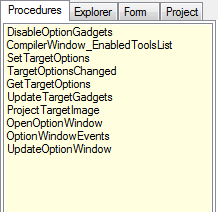
This tool displays a list of all procedures and macros declared in the current source
code. By double-clicking on an entry in that list, the cursor automatically
jumps to that procedure.
Macros will be marked in the list by a "+" sign before the name.
You can also place special comment marks in your code,
that will be displayed in the list too. They look like this: ";- <description>".
The ; starts a comment, the ‘-‘ that follows it immediately defines such a mark.
The description will be shown in the Procedure list, and clicking on it will jump
to the line of this mark. Such a comment mark can be distinguished from a Procedure
by the "> " that is displayed before it in the procedure list.
The list of procedures can be sorted, and it can display the procedure/macro arguments in the list.
For these options, see Configuring the IDE.
Project Panel

This tool displays a tree of all files in the current project. A double-click on a file
opens it in the IDE. This allows fast access to all files in the project. A right-click on a file opens a context menu
which provides more options:

Open - Open the file in the IDE.
Open in FileViewer - Open the file in the FileViewer of the IDE.
Open in Explorer - Open the file in the operating systems file manager.
Add File to Project - Add a new file to the project.
Remove File from Project - Remove the selected file(s) from the project.
Refresh AutoComplete data - Rescan the file for AutoComplete items.
Explorer
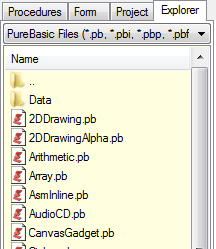
The Explorer tool displays an explorer, from which you can select files and open
them quickly with a double-click. PureBasic files (*.pb, *.pbi, *.pbp, *.pbf) will
be loaded into the edit area and all other recognized files (text & binary) files
will be displayed into the internal File Viewer.
Variable Viewer
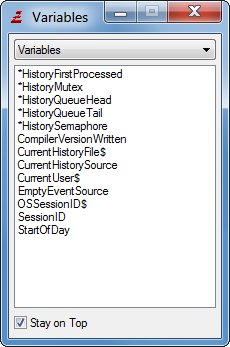
The variable viewer can display variables,
Arrays, lists,
Constants, Structures
and Interfaces defined in your source code, or
any currently opened file. You can configure what exactly it should display in
the preferences.
Note: The displaying of variables is somewhat limited for now. It can only detect
variables explicitly declared with Define,
Global, Shared,
Protected or Static.
Code Templates

The templates tool allows you to manage a list of small code parts, that you can
quickly insert into your source code with a double-click. It allows you to manage the
codes in different directories, and put a comment to each code. This tool is perfect to
manage small, often used code parts.
Issue Browser

The issue browser tool collects comments in the source code that fit a defined format
and lists them ordered by priority. It can be used to track which areas of the
source code still need to be worked on.
Each displayed issue corresponds to one comment in
the code. A double-click on the issue shows that code line. Issues can be displayed for
the current file, or for multiple files (all open files, or all files that belong to
the current project).
The issue list can also be exported in CSV format.
To configure the collected issues, see the "Issues" section in the
Preferences.
Color Picker

The color picker helps you to find the perfect color value for whatever task you need.
The following methods of picking a color are available:
RGB: Select a color by choosing red, green and blue intensities.
HSV: Select a color by choosing hue, saturation and value.
HSL: Select a color by choosing hue, saturation and lightness.
Wheel: Select a color using the HSV model in a color wheel.
Palette: Select a color from a predefined palette.
Name: Select a color from a palette by name.
The color selection includes an alpha component, if the "Include alpha channel" checkbox is activated.
The individual components (red/green/blue intensities or hue/saturation/lightness) as well as
the hexadecimal representation of the current color can be seen and modified in the text fields.
The "Insert Color" button inserts the hexadecimal value of the current color in the source code.
The "Insert RGB" button inserts the color as a call to the RGB() or
RGBA() function into the code. The "Save Color" button saves the current color
to the history area at the bottom. Clicking on a color in the history makes it the current color again.
Character Table

The character table tool displays a table showing the first 256 unicode characters, together with
their index in decimal and hex, as well as the corresponding html notation. By double-clicking
on any line, this character will be inserted into the source code. With the buttons on the
bottom, you can select which column of the table to insert on a double-click.
Help Tool

The Help Tool is an alternative viewer for the reference guide. It can
be used to view the PureBasic manual side by side with the code. Whether or not the F1 shortcut opens
the manual in the tool or as a separate window can be specified in the
preferences.
Other built-in tools
Structure Viewer

The structure viewer allows you to view all the Structures, Interfaces and Constants
predefined in PureBasic. Double-clicking on a Structure or Interface shows the
declaration. On top of the list you can select a filter to display only entries that
start with a given character.
The "Back" button navigates back through the viewed entries.
"Insert name" inserts just the name of the selected entry.
"Insert copy" inserts a copy of the declaration of that entry.
"Insert" lets you enter a variable name and then inserts a definition of that variable
and the selected entry and all elements of it.
File Viewer

The internal file viewer allows you do display certain types of files. Text files,
images and web pages (windows only). Any unknown file type will be displayed in a
hex-viewer. The "Open" button opens a new file, the "X button" closes it and the
arrows can be used to navigate through the open files.
Also any binary file that you attempt to open from the Explorer tool, or by
double-clicking on an IncludeBinary keyword will be
displayed in this file viewer.
Compare Files/Folders
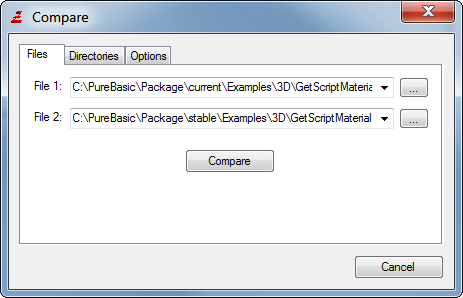
This tool can compare two (text-) files or two directories and highlight their differences.
The "Options" tab can be used to ignore some differences such as spaces or upper/lowercase changes.

The files are shown side by side with the differences marked in the following way:
Lines shown in red were removed in the file on the right, lines shown in green were added
in the file on the right and lines shown in yellow were changed between the two files.
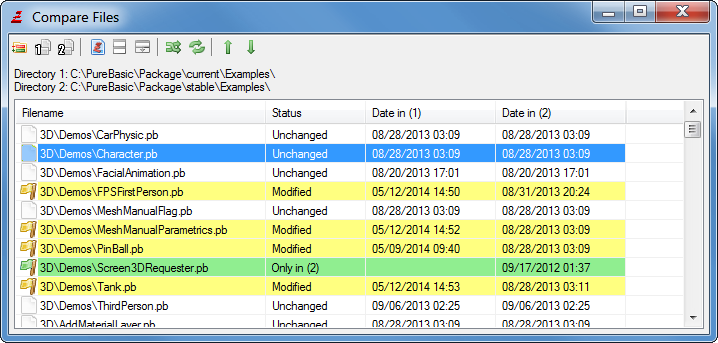
When comparing directories, the content of both directories is examined (with the option to filter
the search by file extension and include subdirectories) and the files are marked in a similar way:
Files in red do not exist in the second directory, files in green are new in the second directory and
files in yellow were modified. A double-click on a modified file shows the modifications made
to that file.
Other entries in the Tools menu
Form Designer

The Form Designer can be used to design the user interface for you
application. For more information, see the form designer chapter.















